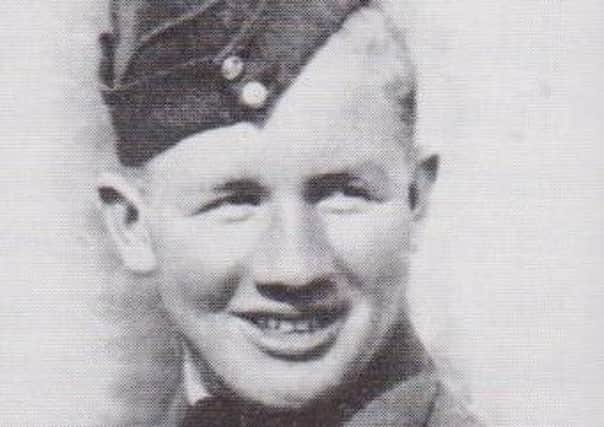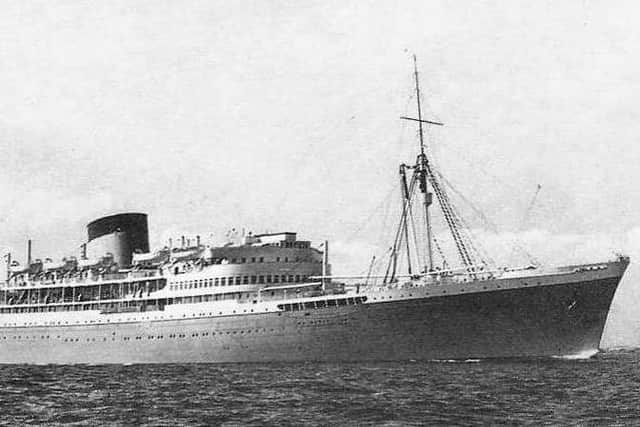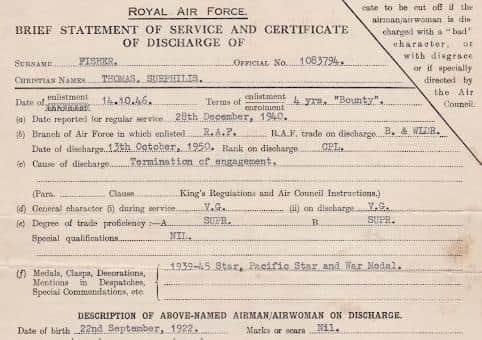Local man’s harrowing memories of WWII Japanese prison camp


When Japan surrendered, Northern Ireland and most of the world celebrated.
“Our hearts are full to overflowing, as are your own,” said King George VI, speaking to the nation on the radio.
Advertisement
Hide AdAdvertisement
Hide Ad“Yet there is not one of us who has experienced this terrible war who does not realize that we shall feel its inevitable consequences long after we have all forgotten our rejoicings of today.”


Meanwhile, in Ikuno Prison Camp near Osaka in Japan, the Japanese guards were getting “excited and agitated.”
The late Tommy Fisher, founder of Fisher Engineering in Ballinamallard in 1950, was an RAF Prisoner of War in Ikuno and it would be the end of the month before an American plane dropped leaflets explaining the surrender and his evacuation.
His extraordinary, if harrowing, POW memories were recorded and written down in the year 2000 by family friend Helen Stuart (nee Nawn).
Advertisement
Hide AdAdvertisement
Hide AdFor Tommy, and for many, many like him, from numerous creeds and nationalities - men, women and children - August 15, 1945 came after unimaginably cruel treatment from Japanese soldiers, prison guards, and their associates.


And for tens of thousands of POWs who perished at the hands of their captors, the surrender came too late.
It is with heartfelt thanks and enormous gratitude to the Fisher family and Helen Stuart that some short extracts from Tommy Fisher’s memoirs are being shared here today - his journey to Japan by ship, his capture, and on Friday his POW experiences.
Helen noted at the beginning of the precious document: “It has been a joy to put together this fascinating story and I feel honoured to have been asked to retell the tale.”
Advertisement
Hide AdAdvertisement
Hide AdIn contrast to his terrible POW experiences, Tommy’s story begins, very evocatively, in post-card picturesque Irish countryside.
He was the eldest of a family of eight, born on September 22, 1922 into a “very old rambling thatched house” near the small, farming village of Newtowngore in County Leitrim.
Tommy went to the local National School when he was six, left at 13-and-a-half, worked on the family farm and won the greatly coveted Killeshandra Creamery Prize and Cup for ploughing.
There was no conscription in Ireland north or south when he volunteered to join the RAF and “it was not because I was unhappy at home,” he said.
Advertisement
Hide AdAdvertisement
Hide Ad“I enjoyed farming…but reading all the publicity about the war…and listening to the (mainly military) music on the radio, gave me the urge to join up, with the feeling that there was something more to life than farming.”
He joined the RAF and sailed east in July 1941 on the Belfast-built Stirling Castle troop ship, celebrating his 19th birthday in Bombay before docking in Singapore in October 1941.
Tommy was stationed at Kalang on the edge of the city, working in the RAF Embarkation Staff Office.
On December 7, 1941 the Japanese bombed the city without warning.
Advertisement
Hide AdAdvertisement
Hide Ad“The Japanese jumped the gun here,” he explained in his memoirs, “because war was not officially declared until December 8.”
Tommy worked in the office in the docks at Kepil Harbour till February 12, 1942, during which time “the harbour was bombed almost every day. Japanese planes in groups of 27 (three formations of nine) came over…and dropped all their bombs. We had at the most 20 minutes warning.”
They hid in makeshift air raid shelters of bales of raw rubber.
“The docks received a dreadful hammering from the bombers and several ships were sunk.”
The end was in sight.
Advertisement
Hide AdAdvertisement
Hide Ad“The Japanese came down through Malaya like a sheet of lightning” he explained, adding “Singapore fell to the Japanese…certainly one of the greatest disasters of WWII.”
On Black Sunday, February 15, 1942, Lieutenant General Percival signed the surrender.
“Many are the stories of atrocities carried out by the Japanese on the island,” Tommy recalled.
“The worst being when they took over Alexandra Military Hospital.
Advertisement
Hide AdAdvertisement
Hide Ad“Here they bayonetted doctors and nurses and even patients in the operating theatres and those who were not killed that night were taken out the next morning and shot.”
Singapore surrendered on February 15 but “we received orders to get out three days before that…I managed to get on a cargo ship called the Empire Star which was one of the last to be boarded.”
Having survived three enemy attacks the ship limped into Batavia in Java (now Jakarta in Indonesia) where Tommy was stationed in Porwakerto “a camp which was nearly in the centre of Java, beside a big volcano…with the steam coming out of the top. This was Krakatoa.”
They were in Porwakerto for about ten days when the Japanese invaded Java.
Advertisement
Hide AdAdvertisement
Hide AdThe majority of the RAF men left on a train bound for Tjilajap where there was supposed to be a ship waiting to evacuate them to Australia.
After about 45 minutes on the train they were ambushed and machine gunned by Japanese paratroopers.
Some of the airmen escaped, others were caught and bayonetted to death by the Japanese.
Tommy and a group of comrades were captured, ordered to lie in a rice field covered by a big Japanese machine gun, and taken to their first POW camp.
Continued on Friday.